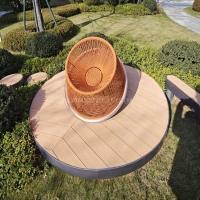Welcome to the website for landscape facilities products and knowledge.
How can a landscape bar counter be designed to accommodate both seated and standing guests?
Crafting a landscape bar counter that successfully caters to both seated and standing guests requires a deliberate and thoughtful approach to design, merging ergonomics with social dynamics. The primary strategy involves implementing a multi-level or multi-height counter system. This design incorporates distinct sections at varying elevations. A standard 42-inch (107 cm) high section is ideal for standing guests, allowing them to comfortably rest their arms and place drinks without slouching. Adjacent to this, a lower section at the conventional 30-inch (76 cm) table height provides a perfect spot for seated patrons. This tiered approach not only defines functional zones but also adds visual interest and architectural depth to the space.
Beyond height variation, the counter's depth and toe-kick are critical. A deeper overhang, around 15-18 inches (38-46 cm), is essential for the seated area to provide ample legroom. A recessed toe-kick of about 4 inches (10 cm) further enhances comfort for those sitting on bar stools. For the standing section, a shallower depth of 12 inches (30 cm) is sufficient, encouraging a more casual, lean-in posture. The strategic placement of sturdy footrails along the base of the standing area offers additional support and comfort, allowing guests to shift their weight.
Material selection plays a dual role in aesthetics and durability. The countertop surface must be resilient to withstand constant use, spills, and cleaning. Quartz, sealed granite, or high-pressure laminates offer excellent durability and a wide range of design options. The edge profile is a subtle yet important detail; a slightly rounded or beveled edge is more comfortable for resting arms than a sharp, square one.
Fostering a social atmosphere is a key goal. The design should encourage interaction between the two groups. Avoiding a solid visual barrier between the different height sections is crucial. Using materials that allow sightlines, or designing a flowing, serpentine shape can connect the spaces rather than segment them. This layout facilitates natural conversation between friends seated at the lower level and others who are standing nearby.
Finally, integrating practical elements elevates the experience. Dedicated and accessible power outlets or USB charging ports along the bar face are a modern necessity. Strategic under-counter lighting, such as subtle LED strips, can illuminate the area for both functionality and ambiance, making the bar a focal point. By harmonizing these elements—multi-level heights, thoughtful ergonomics, durable materials, and social connectivity—a landscape bar counter becomes a versatile and inviting hub that effortlessly accommodates every guest's preferred way to enjoy the space.
Related search:

Recommendation
Swivel chair-Specialty steel structure woven rattan leisure chair with rotatable design